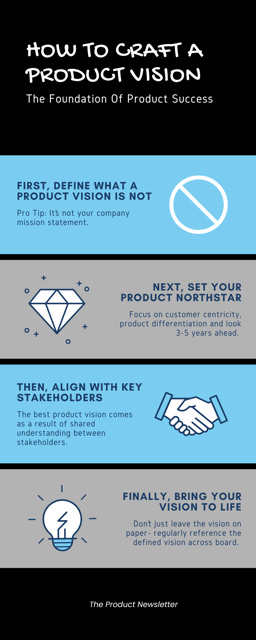Product Vision- The Foundation of Product Success
A strong product vision sets great products apart, but I learned that the hard way. In this piece, I share tips on how to craft a vision that drives execution and delivers standout experiences
Hi 👋! You are reading one of my free articles - I hope it helps you level up your PM skills. Want to go deeper? My premium subscribers get exclusive frameworks and strategies I don’t share anywhere else - content that has helped hundreds of product managers land better roles and make bigger impact.
Ready to accelerate your product career? Subscribe now for premium access and join a community of exceptional PMs gaining an edge every week.
Now, let’s dive into today’s insights...
Taking the time to craft a strong product vision has been a game-changer for the products my teams have built, but that wasn’t always the case. Early on, we struggled with unclear visions, learning the hard way how much they impact execution. Over time, we got better.
A product vision defines the future state of your product and its impact on customers. But more than just a statement, it is the guiding light that aligns teams, drives decisions, and transforms good products into exceptional ones.
Why Product Vision Matters
When teams lack a clear product vision, even the most talented organizations can end up building features without purpose or chasing market trends without direction. A strong vision isn’t just inspiring—it’s the foundation for every strategic decision your team makes.
Think of product vision as the destination on your product journey. Without it, you’re just wandering, hoping to stumble upon success. With it, every decision—from the smallest feature to the biggest strategic pivot—stays aligned with a clear, guiding standard.
What Product Vision Is Not
Many confuse product vision with related but distinct concepts.
A product vision is not:
Your company mission statement. While your mission defines your organization’s broader direction, your product vision focuses on how your product will serve customers and stand out in the market.
A list of features or technical specs. Vision goes beyond the “what” to address the “why”—the core value your product delivers.
An unattainable dream. A strong vision balances ambition with reality, inspiring teams while staying grounded in what’s achievable.
Crafting an Effective Product Vision
The most impactful product visions share key characteristics:
Customer Centricity: They focus relentlessly on customer needs and outcomes rather than technical capabilities or internal metrics.
Clear Differentiation: They clearly define why customers will choose your product over competitors—without relying on vague superlatives like “best” or “leading.”
Future Focused: They look ahead 3-5 years while remaining credible and achievable.
Consider Netflix’s early vision:
“To become the best global entertainment distribution service, licensing entertainment content around the world, creating markets that are accessible to filmmakers, and helping content creators around the world to find a global audience.”
This vision balanced ambition with achievability while clearly articulating value for both consumers and content creators.
Building Alignment Through Collaboration
The process of creating your vision matters as much as the vision itself. Rather than developing it in isolation and announcing it to stakeholders, successful product leaders take a collaborative approach.
The Kindle team exemplified this when developing their vision. Instead of simply declaring they would create the best e-reader, they engaged with readers, authors, and publishers to understand what made physical books special. This led to their vision of creating “a weightless object that lasts forever and is readable in any light” – a vision that resonated with stakeholders because it emerged from shared understanding.
Implementing and Evolving Vision
Your product vision should inform the following:
Strategic Planning: Every roadmap item should connect to your vision.
Feature Decisions: New capabilities should advance your progress toward the vision.
Team Communication: Regular reference to the vision helps maintain alignment and focus.
Moving Forward
Creating an effective product vision requires time, thought, and collaboration. But the investment pays dividends through better decision-making, stronger team alignment, and ultimately, more successful products.
Remember: Your vision isn’t just words on a page. It’s a commitment to your team and customers about the future you’ll build together.





